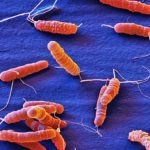Lien vers Pubmed [PMID] – 20368342
Infect. Immun. 2010 Jun;78(6):2782-92
In addition to their classical roles as carbon or nitrogen sources, amino acids can be used for bacterial virulence, colonization, or stress resistance. We found that original deamidase-transport systems impact colonization by Helicobacter pylori, a human pathogen associated with gastric pathologies, including adenocarcinoma. We demonstrated that l-asparaginase (Hp-AnsB) and gamma-glutamyltranspeptidase (Hp-gammaGT) are highly active periplasmic deamidases in H. pylori, producing ammonia and aspartate or glutamate from asparagine and glutamine, respectively. Hp-GltS was identified as a sole and specialized transporter for glutamate, while aspartate was exclusively imported by Hp-DcuA. Uptake of Gln and Asn strictly relies on indirect pathways following prior periplasmic deamidation into Glu and Asp. Hence, in H. pylori, the coupled action of periplasmic deamidases with their respective transporters enables the acquisition of Glu and Asp from Gln and Asn, respectively. These systems were active at neutral rather than acidic pH, suggesting their function near the host epithelial cells. We showed that Hp-DcuA, the fourth component of these novel deamidase-transport systems, was as crucial as Hp-gammaGT, Hp-AnsB, and Hp-GltS for animal model colonization. In conclusion, the pH-regulated coupled amino acid deamidase-uptake system represents an original optimized system that is essential for in vivo colonization of the stomach environment by H. pylori. We propose a model in which these two nonredundant systems participate in H. pylori virulence by depleting gastric or immune cells from protective amino acids such as Gln and producing toxic ammonia close to the host cells.

